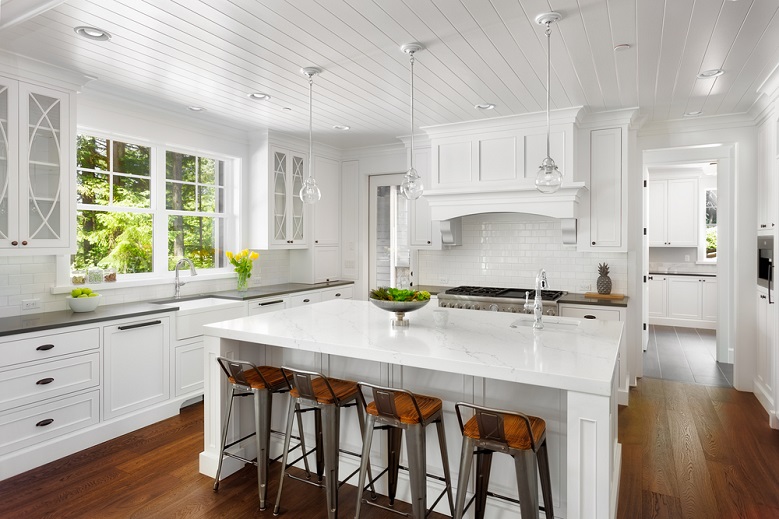
This is the second part in this series, click here for part one of this series.
By Ethan Roberts
Whether you’re an investor with a vacant house or an owner-occupant trying to sell your own home, you need to create a first impression in a buyer’s mind that’s not just favorable, but downright enthralling. We call that having positive “curb appeal.” As we saw in part one of this series, the prospective buyer’s experience begins with the exterior of the home, but it certainly doesn’t end there. We want the interior of the home to also capture the buyer’s heart, mind, and ultimately their signature on a higher priced contract.
Over the years, I’ve seen both Multiple Listing Service (MLS) and by-owner listings in which the seller did little to enhance the interior of the home. Sometimes it seemed as if the seller was so sure the home would sell that they just threw the listing out there, regardless of the condition or dated cosmetic appeal of the interior. This is a huge mistake, and will often cost the seller thousands of dollars in lost profits. Even with tight inventory levels, the competition still dictates that your property must look better than the one down the street if you’re going to sell it fast and for top price.
With that in mind, here are six inexpensive ways to enhance the “curb appeal” of your home’s interior to match the tender loving care you’ve already given the exterior:
- Paint the interior. Just as you need to paint the exterior of the home, you also need to have fresh paint on the interior walls to give a home the best look possible. Realtors tell their customers to keep the paint color “neutral” (off white, light beige, etc.) because those colors reflect light to make the rooms look bigger and because the buyer’s furniture will blend with the walls, no matter what color it is. It’s okay to paint one wall an accent color in a large room, but you still should keep it toned down. Bright orange, chartreuse green, or dark purple will only turn prospective buyers off.
- Clean, clean, clean! Realtors like to say that kitchens and baths sell the home. Therefore, your kitchens and baths can never look too clean! The sink must always be free of dishes, floors must be mopped, and the appliances wiped clean. In the bathrooms, make sure the shower, tub and toilets are spotless. Granted, it’s difficult to sell a home that’s lived in when 10 minutes after you clean, the family or pets track dirt onto the floors again or make a mess in the kitchen. Nevertheless, cleanliness is imperative if you want to get the home sold fast.
- Keep it light, bright, and airy. I have to chuckle when a seller shows a home worth hundreds of thousands of dollars, but doesn’t want to spend 20 cents to turn all the lights on throughout the home. Turn on those lights! Replace burnt-out bulbs, and open the blinds or curtains to let natural light come in and expand the perceived size of the house. A dark home looks smaller and makes it difficult for buyers to warm emotionally to the home.
- Make it smell good. In past decades, Realtors would put a drop of vanilla on a light bulb or bake cookies for an open house to make the home more appealing. Some of those ploys are bit hokey by today’s standards, but you still want the home to smell clean and fresh. That means dirty laundry put away, garbage taken out daily, heating and air filters changed regularly, cat litter boxes emptied frequently, a few open boxes of baking soda, and perhaps most important of all—no smoking in the house or garage!
- De-clutter everywhere. Over time, homes become cluttered with everyday items that make them appear smaller. Walk through each room with an empty box and put everything that isn’t necessary into the box. Then store the box in the attic or garage until your home sells. Clear closet floors and put everything up on the shelves. Minimize personal items on refrigerators and photos on the walls. Your objective is to make the home appear as large as possible and to allow the prospective buyer to project how their own items will look in their new home.
- Make those repairs! Kitchen faucets that leak or are rusted need to be replaced. In the bathroom, change out old rusted sinks and fix that running toilet. Other common needed repairs in many homes are doors that won’t close properly or squeak, broken outlet or wall plates, and windows that either don’t open or won’t stay open. For maximum appeal, fix these before you list the home.
If you’re an investor who’s flipping or renting a home, focus most of your dollars on cosmetic improvements to the kitchen and bathrooms. You can really enhance the look and value of a home by changing countertops, updating old flooring, and adding a backsplash. Even simple updates, like the ones I made last year to this home built in 1990, can make a dramatic difference.
BEFORE: Old, dated wallpaper, original counter top, dishwasher, and faucet. Screams 1990s!
AFTER: I removed the wallpaper removed and replaced it with fresh beige paint, and installed a new countertop, sink faucet, and dishwasher.
When it comes to interiors, you want to create the same “Wow” factor that you have with the exterior, so you can sell that home faster and for a much better price.
The bottom line: When the buyers walk into the home and you hear them say “Wow!” to each other, you’ll know that all of your rehabbing efforts will soon be paying off.
 Ethan Roberts is a real estate writer, editor and investor. He’s a frequent contributor to InvestorPlace.com, and his work has been featured on Money.msn.com and Reuters.com. He’s also written for SeekingAlpha.com and MarketGreenhouse.com, and was one of five contributing editors to TheTycoonReport.com. He’s been investing in real estate since 1995 and has been a Realtor since 1998. He also teaches classes on investing in residential real estate.
Ethan Roberts is a real estate writer, editor and investor. He’s a frequent contributor to InvestorPlace.com, and his work has been featured on Money.msn.com and Reuters.com. He’s also written for SeekingAlpha.com and MarketGreenhouse.com, and was one of five contributing editors to TheTycoonReport.com. He’s been investing in real estate since 1995 and has been a Realtor since 1998. He also teaches classes on investing in residential real estate.



